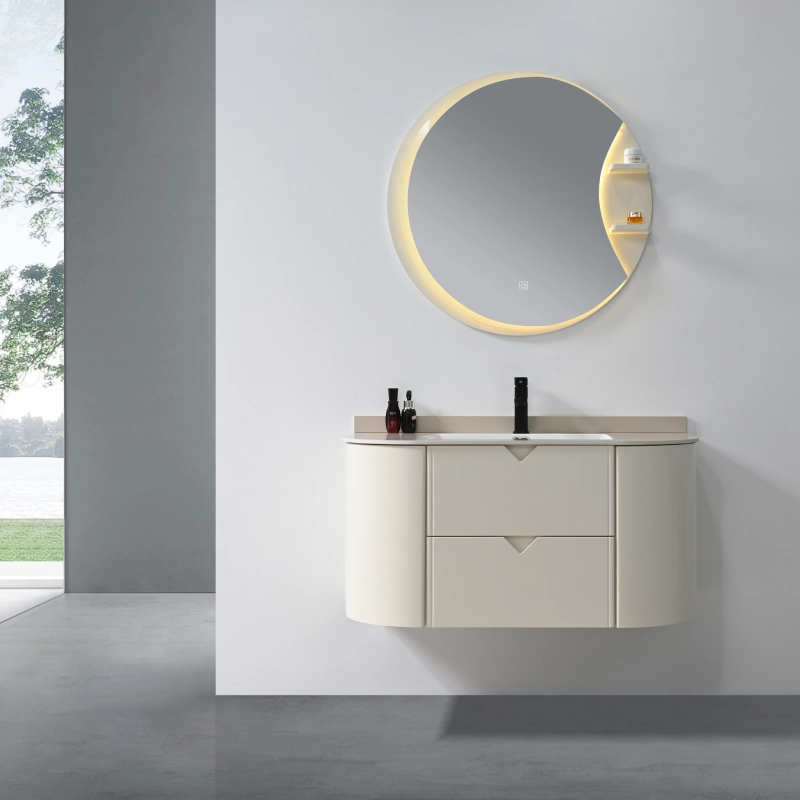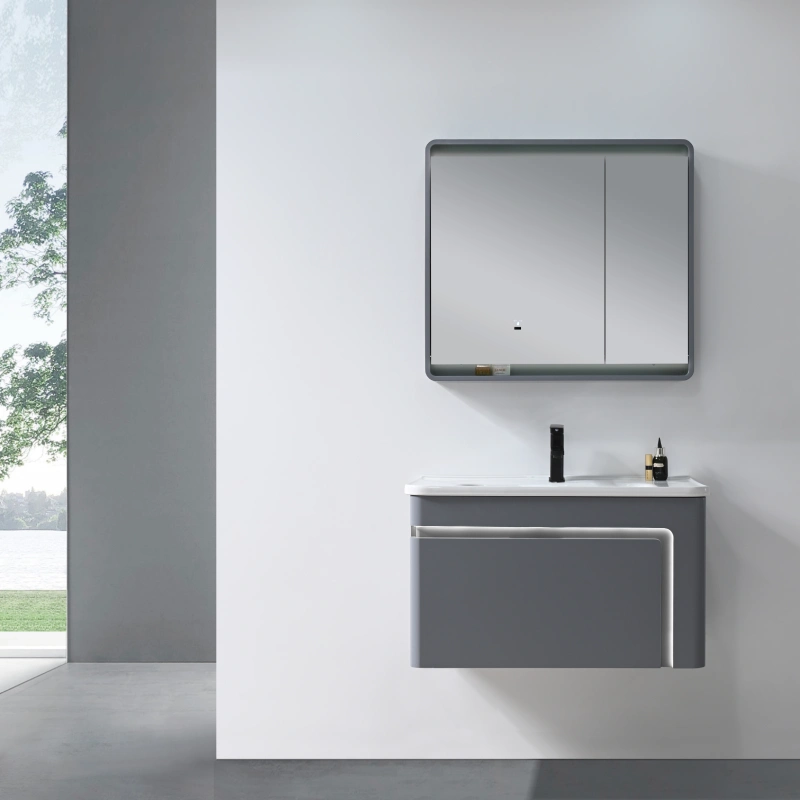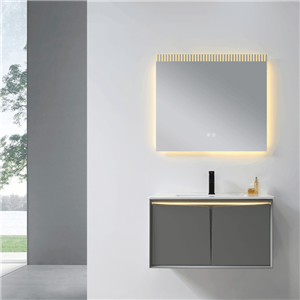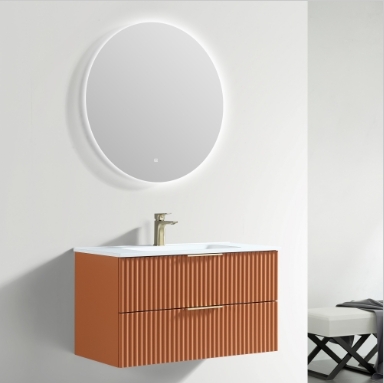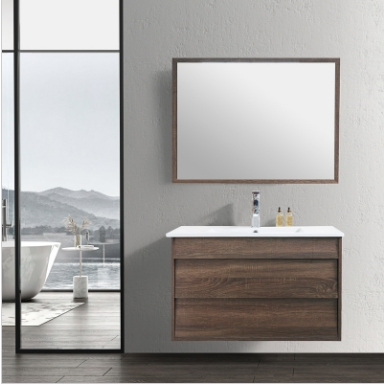Comparación de materiales para gabinetes de baño: ¿cuál se adapta mejor a sus necesidades?
Gabinete de baño de MDF 2024 Nueva llegada
Siga con nosotros
PVC Bathroom Cabinet (Polyvinyl Chloride)
Pros: PVC is highly moisture-resistant, making it an excellent choice for bathroom environments where humidity and water exposure are common. It is also easy to clean and maintain, and it resists corrosion, making it a durable option. PVC cabinets are lightweight and available in a variety of colors and finishes, allowing for versatile design choices.
Cons: While PVC is durable, it can be less sturdy compared to wood-based materials and may not provide the same level of strength. It is also susceptible to scratches and can fade over time when exposed to direct sunlight.
Plywood Bathroom Cabinet
Pros: Plywood is a strong and durable material made from thin layers of wood veneer glued together. It is more resistant to warping and shrinking compared to solid wood, making it suitable for bathroom use. Plywood can be finished with various veneers or laminates to achieve different looks, and it offers a good balance between strength and weight.
Cons: Although plywood is more moisture-resistant than solid wood, it can still be susceptible to water damage if not properly sealed and maintained. It is generally more expensive than MDF and may require additional finishing to achieve a smooth surface.
MDF Bathroom Cabinet (Medium-Density Fiberboard)
Pros: MDF is an engineered wood product made from wood fibers combined with resin and wax. It is smooth and uniform, making it ideal for painted finishes and intricate designs. MDF is cost-effective and provides a consistent appearance without the imperfections found in natural wood. It is also relatively stable and resists cracking and warping.
Cons: MDF is more susceptible to water damage compared to plywood and PVC, so it is crucial to use it in areas with proper ventilation and where it is less likely to come into direct contact with water. It is also heavier than plywood and can be more challenging to handle during installation.
By understanding the strengths and weaknesses of these materials, you can better decide which one aligns with your needs and preferences. In the following sections, we will delve deeper into each material, providing detailed insights to help you make the best choice for your bathroom cabinets.
How to Choose Between PVC, Plywood, and MDF Bathroom Cabinets
When selecting bathroom cabinet materials, it's important to weigh the pros and cons of PVC, Plywood, and MDF. Here's a deeper look into each material to help you make an informed decision.
PVC Bathroom Cabinets
Pros of PVC Cabinets:
Moisture Resistance: PVC is highly resistant to moisture, making it an excellent choice for bathrooms where humidity and water exposure are common. This characteristic helps prevent issues like swelling, warping, and mold growth.
Easy Maintenance: PVC cabinets are easy to clean and maintain. A simple wipe-down with a damp cloth is usually enough to keep them looking new.
Durability: PVC is resistant to corrosion and does not suffer from termite attacks, ensuring long-lasting performance.
Versatile Design: Available in various colors and finishes, PVC cabinets can easily match different bathroom styles and preferences.
Cons of PVC Cabinets:
Strength: While PVC is durable, it is less sturdy compared to wood-based materials like plywood. This can affect the cabinet's load-bearing capacity.
Scratches and Fading: PVC can be prone to scratches and may fade over time if exposed to direct sunlight. Proper placement and care can mitigate these issues.
Plywood Bathroom Cabinets
Pros of Plywood Cabinets:
Strength and Stability: Plywood is made by gluing together thin layers of wood veneer, which gives it excellent strength and stability. It is less likely to warp or shrink compared to solid wood, making it suitable for bathroom environments.
Versatile Finishes: Plywood can be finished with various veneers or laminates, providing a wide range of design options to suit different aesthetic preferences.
Cost-Effective: Plywood offers a good balance between cost and performance, providing durability and strength at a relatively affordable price.
Cons of Plywood Cabinets:
Moisture Susceptibility: Although more resistant to moisture than solid wood, plywood can still suffer from water damage if not properly sealed and maintained. Regular sealing and careful placement can help extend its lifespan.
Additional Finishing: Plywood often requires additional finishing to achieve a smooth surface, which can add to the overall cost and effort during installation.
MDF Bathroom Cabinets
Pros of MDF Cabinets:
Smooth Surface: MDF offers a smooth and uniform surface, making it ideal for painted finishes and intricate designs. It is free from knots and grain patterns, providing a consistent appearance.
Cost-Effective: MDF is generally more affordable than plywood and solid wood, making it a budget-friendly option for bathroom cabinets.
Stability: MDF resists cracking and warping, ensuring that cabinets maintain their shape and structure over time.
Cons of MDF Cabinets:
Water Sensitivity: MDF is more susceptible to water damage compared to PVC and plywood. It is crucial to ensure proper ventilation in the bathroom and avoid direct water exposure to extend the lifespan of MDF cabinets.
Weight: MDF is heavier than plywood, which can make installation more challenging. Proper support and installation techniques are necessary to ensure stability.
By understanding these details, you can make a more informed choice about the material that best suits your bathroom cabinet needs. Consider the environment of your bathroom, your budget, and the specific requirements of your space when making your decision.
Summarizing the Best Bathroom Cabinet Materials: PVC, Plywood, and MDF
Selecting the right bathroom cabinet material is essential for creating a bathroom that is both functional and stylish. By understanding the pros and cons of PVC, Plywood, and MDF, you can make an informed decision that meets your specific needs and preferences.
PVC offers exceptional moisture resistance, easy maintenance, and versatile design options, making it ideal for modern bathrooms and high-humidity environments. However, it may not provide the same level of sturdiness as wood-based materials and can be prone to scratches and fading.
Plywood provides excellent strength, stability, and a wide range of finish options. It is suitable for various bathroom styles, from traditional to modern. While it is more resistant to warping and shrinking than solid wood, it still requires proper sealing and maintenance to prevent water damage.
MDF is cost-effective, smooth, and perfect for painted finishes and intricate designs. It offers stability and resists cracking and warping, but it is more susceptible to water damage and is heavier, making installation more challenging.
When choosing the material for your bathroom cabinets, consider factors such as moisture resistance, durability, cost, aesthetics, maintenance, and installation. Matching the material with your bathroom style—whether modern, traditional, rustic, or eclectic—will help you achieve a cohesive and visually appealing space.
By making a well-informed choice, you can ensure that your bathroom cabinets not only enhance the look of your bathroom but also provide long-lasting functionality.
Explore Our Range of Custom Bathroom Cabinets
Ready to transform your bathroom with the perfect cabinets? Explore our range of custom bathroom cabinets made from high-quality PVC, Plywood, and MDF. Contact us today to find the ideal solution for your bathroom needs and get expert advice on choosing the right material for your space.
Follow Us On Facebook

